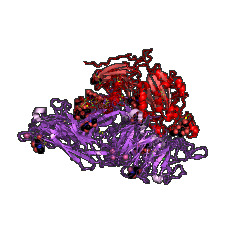INBIntegrin beta subunits (N-terminal portion of extracellular region) |
|---|
| SMART accession number: | SM00187 |
|---|---|
| Description: | Portion of beta integrins that lies N-terminal to their EGF-like repeats. Integrins are cell adhesion molecules that mediate cell-extracellular matrix and cell-cell interactions. They contain both alpha and beta subunits. Beta integrins are proposed to have a von Willebrand factor type-A "insert" or "I" -like domain (although this remains to be confirmed). |
| Interpro abstract (IPR002369): | Integrins are the major metazoan receptors for cell adhesion to extracellular matrix proteins and, in vertebrates, also play important roles in certain cell-cell adhesions, make transmembrane connections to the cytoskeleton and activate many intracellular signalling pathways [ (PUBMED:12297042) (PUBMED:12361595) ]. An integrin receptor is a heterodimer composed of alpha and beta subunits. Each subunit crosses the membrane once, with most of the polypeptide residing in the extracellular space, and has two short cytoplasmic domains. Some members of this family have EGF repeats at the C terminus and also have a vWA domain inserted within the integrin domain at the N terminus. Most integrins recognise relatively short peptide motifs, and in general require an acidic amino acid to be present. Ligand specificity depends upon both the alpha and beta subunits [ (PUBMED:12234368) ]. There are at least 18 types of alpha and 8 types of beta subunits recognised in humans [ (PUBMED:14689578) ]. Each alpha subunit tends to associate only with one type of beta subunit, but there are exceptions to this rule [ (PUBMED:2467745) ]. Each association of alpha and beta subunits has its own binding specificity and signalling properties. Many integrins require activation on the cell surface before they can bind ligands. Integrins frequently intercommunicate, and binding at one integrin receptor activate or inhibit another. Integrins are important therapeutic targets in conditions such as atherosclerosis, thrombosis, cancer and asthma [ (PUBMED:2199285) ]. At the N terminus of the beta subunit is a cysteine-containing domain reminiscent of that found in presenillins and semaphorins, which has hence been termed the PSI domain. C-terminal to the PSI domain is an A-domain, which has been predicted to adopt a Rossmann fold similar to that of the alpha subunit, but with additional loops between the second and third beta strands [ (PUBMED:9009218) ]. The murine gene Pactolus shares significant similarity with the beta subunit [ (PUBMED:9535848) ], but lacks either one or both of the inserted loops. The C-terminal portion of the beta subunit extracellular domain contains an internally disulphide-bonded cysteine-rich region, while the intracellular tail contains putative sites of interaction with a variety of intracellular signalling and cytoskeletal proteins, such as focal adhesion kinase and alpha-actinin respectively [ (PUBMED:9818167) ]. Integrin cytoplasmic domains are normally less than 50 amino acids in length, with the beta-subunit sequences exhibiting greater homology to each other than the alpha-subunit sequences. This is consistent with current evidence that the beta subunit is the principal site for binding of cytoskeletal and signalling molecules, whereas the alpha subunit has a regulatory role. The first 20 amino acids of the beta-subunit cytoplasmic domain are also alpha helical, but the final 25 residues are disordered and, apart from a turn that follows a conserved NPxY motif, appear to lack defined structure, suggesting that this is adopted on effector binding. The two membrane-proximal helices mediate the link between the subunits via a series of hydrophobic and electrostatic contacts. This domain corresponds to the integrin beta VWA domain. |
| Family alignment: |
There are 4366 INB domains in 4356 proteins in SMART's nrdb database.
Click on the following links for more information.
- Evolution (species in which this domain is found)
- Literature (relevant references for this domain)
- Disease (disease genes where sequence variants are found in this domain)
- Metabolism (metabolic pathways involving proteins which contain this domain)
- Structure (3D structures containing this domain)
- Links (links to other resources describing this domain)

































































